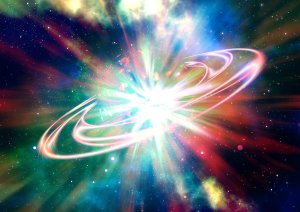This essay by Cort Odekirk is reprinted with his permission.
I
The Pattern and the Logrus represent Order and Chaos, two opposing forces kept in a precarious balance. However, we know from references Dara made to Corwin that at least the Courts of Chaos existed before the Pattern. No mention is made of the formation date of the Logrus, but if the Courts existed before the Pattern then it is reasonable to assume that the Logrus did as well. Perhaps it is this lopsided existence that forced Dworkin to create the Pattern. In any case, the implication is that both are, relatively speaking, recent additions to the universe. Given that, we are forced to wonder, what was there before?
Order and Chaos are formative elements, they structure or break down but they do not create or destroy, in simpler terms, they must exist within a medium, but cannot exist as a medium.
So what is the medium they exist within? One big pointer is the Abyss, a convenient garbage disposal in the backyard of Chaos that seems to effectively destroy whatever is tossed in. So, we have a force for destruction, it seems only logical given the balance prone nature of Zelazny’s universe that we should also have a force for creation. There is only one power we have seen that can actually “create”, the Pattern can find, the Logrus summon, Shapeshift mimic, but only Majick can create.
So if Majick is the fourth great force, why is it so weak relative to the others? In order to understand this we must look at the source. The Pattern and the Logrus exist as point sources, becoming progressively weaker as one moves away from their central point of generation. The Abyss does not radiate, it absorbs although we can assume there is probably a backlog of majick on its event horizon, possibly explaining the seeming surplus of sorcerers in the Courts of Chaos. Majick seems to have no point source, so let us theorize that it is spontaneously generated at all points in the universe, creating not a point source, but a general field. This field, being spread out, would tend to be weaker than the Logrus and Pattern at their points of concentration, however, would probably be stronger than them at their nadir.
So we now have a universe of four forces. the Pattern (representing Order), the Logrus (representing Chaos or change), the Abyss (representing Entropy) and Majick (representing Vitae or creation).
II
This leads us again to the same question, what was there before? As it stood before, Vitae (Majick) existed as a medium, being regulated and controlled by Entropy (Abyss). Into this system we suddenly, and violently, introduce conflicting Order (Pattern) and Chaos (Logrus); structuring and restructuring the otherwise tranquil Vitae into Shadow.
One can only imagine the annoyance of the previous occupants.
Corwin’s experiences as chronicled suggest that Order and Chaos restructure Shadow (Vitae) in waves, concentric rings that spread out from their point source growing gradually weaker the farther away they spread from that point source. As those waves move through the medium they spread their influence on the Vitae, as we have seen in the rather dramatic example in Corwin’s The Courts of Chaos. Now most waves coming from the Logrus or Pattern are much smaller, and the local occupants would be quite unaware of their presence. However, one can assume they would share characteristics in common with the Primal wave, including a spot in the Wavepeak where Vitae is caught in the act of creation, for a moment released from structuralizing influences and reverting to its natural state.
In the Courts of Chaos, Corwin spent only moments in the Vitae, using the Jewel to pass through the Wave and beyond it. However, what if one were to stay with the Wave, matching one’s movement to the Wavefront? The interior of the Wave would now become a world; a world moving, but from within this would not be apparent. Within the Wave would be a world of primal Vitae, bendable to the stronger will and existing until the wave struck the opposing pole of Order or Chaos, something around a week subjective time if Corwin’s primal wave is any example. In this case Undershadow would be more properly called Betweenshadow, and would provide a perfect malleable world where some, all or none of the standard rules of reality need apply.
But only for around a week.
III
We know that life existed in the Courts before the Pattern/Logrus, but what about elsewhere. What happened to all the creatures that may have been living in the Vitae before it became Shadow? One can generally assume most became trees, rocks, unattractive green lounge chairs and other undignified components of the new Shadowlands. However, what if some were able to resist the organizing forces of the Pattern and the destructuring influences of the Logrus. They would suddenly find themselves in a new world or worlds, ill fitted to the environment they were suddenly experiencing. They would have two choices, adapt and learn to live in these new Shadow environments, or seek refuge in the native Vitae existing in the Waves, jumping from Wave to Wave across shadow, always staying one step ahead of the destruction of their temporary home by its impact with the Logrus or Pattern. These would be an interesting people, resistant to the force of the Pattern or the Logrus by right of prior reality. They would be able to move through shadow at great speed by riding the Waves but with questionable accuracy and unable to move at all if there were no Waves present.
They would also, in all likelihood, rather resent the Logrus and particularly Dworkin and his Pattern. One can safely assume that the removal of these influences on their world would present a high priority in their lives, that they would use their unique abilities to spy on the rude reality that had replaced their homeland, plotting its eventual restoration.
VITAE INITIATION
In a sense this could be considered advanced Sorcery or Conjuration. Under the four part system presented here, Majick has its source in Vitae and so, in a sense, Sorcery, Conjuration and possibly Trump are all Vitae Initiation.
However there is a point at which the initiate stops using aspects of the power and begins to use the power itself. They must, of course, be familiar with the lesser powers first, so Sorcery is required before study of Vitae Initiation may begin.
VITAE [40, Chaos Psyche, Chaos Endurance]
# Requires: Status as Real, Sorcery
- [15] Imprint: Sense primal Vitae, feel the waves, use sorcery in all locations
- [5] Retune Vitae (effectively shadowwalking, no movement)
- [5] Stormride (Hellride)
- [5] Shadow of Desire (May contain object of desire)
- [5] Manipulate Probability
- [5] Sense & Enter WavePeaks
ADVANCED VITAE [65]
# Requires: VITAE
- [5] Hasten/Slow Waves
- [5] Create Form from Primal Vitae
- [5] Inhibit Sorcery










